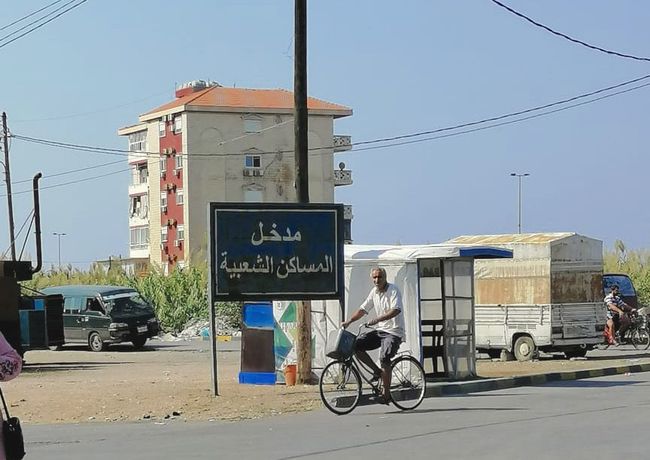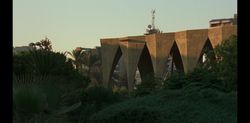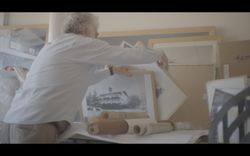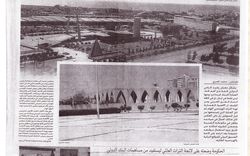Tripoli: Who Took Away Our Land? (Part 2)
Public Works Studio presents the social and environmental repercussions of the city’s public management
This article is based on a research project launched by Public Works Studio in June 2022 to examine Tripoli’s urban issues and consider them in an historical and social context. The project included a series of research workshops, held in October 2021, called “A Participatory Research Space to Activate the Right to the City and Housing in Tripoli,”1 in which a selected group of the city’s residents were invited to take part. The article examines the city’s most significant problems: the planning tools, such as the land consolidation and subdivision projects; degradation of the built environment in the historic districts following their heritage classification; and the deterioration of public housing projects in Tripoli due to poor management. Read Part 1 here
-
During the workshops, the housing problem was addressed mainly in four of the city’s districts: Al-Tal/Zahriyeh, Al-Masaken Al-Shaabya, Al-Hara Al-Jadida (including Hay Al-Tanak), and Hay Dahr Al-Moghr (including the Taht Al-Sibat neighbourhood), with emphasis placed on how the historical context shaped the residents’ relationship with their neighbourhood and the ways in which they apprehend their urban environment and the evictions when they take place. The participants analyzed all the data and stories gathered during their fieldwork and ultimately transformed them into tools for advocacy and organization around a number of problems that emerged in the city. ↩
A Heritage City at the Expense of Its Inhabitants
General consolidation and subdivision is not the only planning tool used in Tripoli and Al-Mina with radical repercussions for their inhabitants.1 Master plans have also been employed, with immediate impacts both on residents and their living conditions and on the process of restoring and rehabilitating historic buildings in old districts. When we look at these plans, it seems obvious that they have been a devastating obstacle to urban planning attempts to improve quality of life, and have caused the death of a number of people following the collapse of buildings on their occupants.2 This has occurred in working-class districts full of old and historic buildings on the verge of crumbling and in the informal neighbourhoods, where housing is in a poor state and the quality of construction is declining.
Similar to the struggle to restore historic buildings in Tripoli and Al-Mina is that in the Taht Al-Sibat district of Tripoli. Situated between the Tripoli Citadel and the Burtasi mosque, overlooking the Abou Ali River, this area is composed of rows of residential buildings, some of which are Mamluk, others Ottoman, and still others built in the early 1970s. Today, the remaining heritage buildings are disintegrating due to negligence, even though they are still occupied; therefore, people are living in deteriorating buildings with cracked walls and ceilings and windows covered with nylon instead of glass, and some families are living in stairwells without light or ventilation. In addition, the structural problems in some buildings are making them prone to collapse.3
There are various reasons for the deterioration of buildings in this neighbourhood and other districts of the old city. The most critical, however, is that these buildings are just about frozen in their condition due to the heritage city classification. The old city is known for its organic and complex urban fabric, but its heritage classification places it under unusual regulations that block intervention, making it more difficult to restore it to meet the population’s needs, in the absence of an integrated plan for financing restoration that would be formulated by public or communal authorities or by the Antiquities Department.
The locality of Taht Al-Sibat was subjected to the conditions of the master development plan of the historic city of Tripoli, which was promulgated in 2007 by decree 1029, in the context of a national campaign for protection of heritage and archaeological zones funded by the World Bank. In the plan, the old city was considered a coherent urban heritage unit.
In reality, meeting the conditions of this plan, most of them aesthetic in nature, required time and material resources that surpassed the capacities of most residents, especially with no funding plan that would enable the authorities concerned to proceed with rehabilitation. The plan for the district also uses a rigid definition of “heritage” that ignores other historical periods, the current collective use of the neighbourhoods, and the social value of the buildings that may make them patrimonial. Even more importantly, these strict measures force residents applying for a permit to consider the additions that they have made to the building in previous years illegal because they do not comply with the new plan; customary construction additions in the historic downtown area are therefore regarded as unlawful practices.4 Because of this, the technical conditions do not contribute to the rehabilitation of the historic space; rather, because of their almost incapacitating nature given the difficult economic conditions, they are counterproductive. The old city is therefore being abandoned and its buildings are eroding, in a context of neglect of public spaces, equipment, and infrastructure.
The example of Taht Al-Sibat shows the reality of the situation of heritage buildings in Tripoli and Al-Mina and highlights the reasons for the “long agony” of the historic core of Tripoli due to its abandonment and the marginalization of its inhabitants, which in the end causes the collapse of heritage buildings or hands them over to investors. At this point, and in the absence of any integrated economic development plan for the Tripoli and Al-Mina neighbourhoods enabling the authorities to improve infrastructure, services, and the structural state of buildings, the policies favouring vacancy and the prohibitive and costly restoration conditions dictated by the master plans are being transformed into an urban development mechanism based on replacement of the poor by the rich, endangerment of the existing population, and evictions. A plan without a development vision and a social component is considered one of the most dangerous aspects of urban planning, especially when it doesn’t take social practices into account in the production of the urban space.
-
For more information, see Public Works Magazine, “Tripoli, a ‘Heritage City’ at the Expense of Its Residents,” 2 April 2022, https://publicworksstudio.com/en/tripoli-a-heritage-city-at-the-expense-of-its-residents/. ↩
-
In 2019, the Al-Fawal building in the Al-Andalus neighbourhood of Al-Mina collapsed, killing a brother and sister. In 2020, an old building partially collapsed in the Al-Zahriyeh district of Tripoli. In 2021, two sisters were killed when a balcony of a building in the Al-Qubba neighbourhood of Tripoli collapsed. In 2022, a three-storey residential building collapsed in the locality of Dahr Al-Moghr in the Al-Qubbah region, following which a five-year-old girl died. ↩
-
According to a study conducted by the Ministry of Culture in 2017, there are more than three hundred heritage buildings in Tripoli with cracks, in a state varying from average danger, to advanced danger, to imminent collapse. There are no official statistics on the state of other buildings. ↩
-
The urbanization processes in these historic neighbourhoods – which existed before the laws on construction and state plans were promulgated – did not historically necessitate the obtaining of approval or the adoption of specific official measures, but relied on negotiations and social approval. ↩
The Tragedy of Incomplete Housing Projects
The last important issue in Tripoli is linked to public housing, its current situation, and the problems surrounding it.1 “Al-Masaken al-Shaabiyya” was one of the most important housing projects2 built by the government in Tripoli; it was mandated by a plan, approved by the Housing Council of the Ministry of Labour and Social Affairs, related to construction of housing projects in the regions of Lebanon. The ministry approved the construction of two hundred residences in Al-Mina on land belonging to the Lebanese Republic, with the goal of selling lodgings on credit to employees of the Tripoli International Fair and to people on limited income. The first stone of the project was laid in March 1971. The residences were two-storey buildings, with front and back yards. Following the beginning of the civil war, in April 1971, work was stopped after 197 dwellings were built and roads were laid; only rough-cast plaster and paint remained to be completed.
In August 1975, families began to move into the vacant dwellings and make them livable without any official coordination. Some inhabitants came from outside the city during the civil war, and others came from neighbouring districts, wishing to improve their standard of living due to the deterioration of housing conditions from where they had come; others moved in so they wouldn’t have to pay rent.
The families completed the construction of the dwellings on their own and modified them to house a larger number of people. Businesses, various institutions, and factories expanded into the area and more housing was built, most of it out of sheet metal. Storeys were also added to existing buildings. And so, a new district was formed in Al-Mina, and it grew until the number of residences reached three hundred in the 1990s, most of them divided into two or three apartments to house children after they got married or for investment purposes. Most of the front yards disappeared. Today, the buildings are inhabited by hundreds of families who have engaged in informal arrangements to acquire a place to live. It should be noted that the neighbourhood saw a significant increase in population density with the wave of refugees arriving in Lebanon after the war in Syria began in 2011. Those with financial means profited from the housing crisis by building new rooms on public or private land near the social housing.
Currently, residents in Al-Masaken al-Shaabiyya face numerous problems, ranging from high population density to deterioration of infrastructure networks, a garbage crisis, the declining state of the buildings, and the emergence of construction problems, as well as humidity and rainwater leaks in the dwellings and other unhealthy conditions. Indeed, according to one of the residents, two attempts3 were made to purchase the buildings and evict them, but both failed.
Given the lack of services and maintenance in the project, the ban on residents maintaining and improving their housing, and the strict interdiction on bringing construction materials into the neighbourhood to modify buildings or build new ones, the residents are demanding that appropriate solutions to their problems be found. The city is ignoring these demands and refusing to provide any services in order to avoid legalizing the presence of squatters, even though the housing project was built by the government on land that belongs to it, and it remains responsible for its maintenance.
Governments intervene in the housing sector in various ways. Between the 1940s and 1970s, housing projects became the most significant policy for welfare states in many countries around the world. In Lebanon – despite the apparent adherence to liberalism – the presence of al-Masaken al-Shaabiyya suggests that the government tried to implement social housing projects. Although the experiment was not limited to Tripoli, the projects were fragmented interventions based on distinct laws or in response to catastrophes. They were then abandoned and, over time, many lost their purpose of providing decent housing. However, it is certain – given the economic collapse and the worsening housing crisis – that such projects could provide a “tangible” starting point for placing social housing at the centre of national policy discourse, in an approach that integrates the reality of these projects into the local context, proposes to deal with their problems, and presents a long-term strategy for managing and maintaining their infrastructure.
-
For more information, see Public Works Studio, “Tripoli: Who Took Away Our Land,” 1 June 2021, https://publicworksstudio.com/en/tripoli-who-took-away-our-land/. ↩
-
In addition to social housing, the government built other housing projects in Tripoli: Al-Mankoubin in Beddawi (1956), the Al-Qubba housing project in Tripoli (2005), and the Khan Al-Askar project (2009). ↩
-
One of these attempts was by Rafik Hariri, the Lebanese prime minister who was assassinated in 2005, who wanted to annex the housing to a vast project linked to La Corniche and transfer the residents to the Al-Qubba residential project. ↩
Conclusion
The state’s practices in Tripoli provide an unequivocal example of how regulatory tools are employed against the interest of the people. These practices include showing contempt for the rights of the residents of informal neighbourhoods; restrictive planning in heritage districts that prevents residents from restoring their dwellings and owners from protecting houses and their inhabitants, leaving them caught between the dilapidated conditions of heritage buildings and the pressure applied by the city’s wealthy real estate speculators; and the creation of social housing projects without thought to their management and then ignoring them in times of distress and crisis, pushing their inhabitants toward precarity. These state practices remain, unequivocally, a testament to how regulatory tools are used against the interest of the people, and a form of dispossession in the context of Tripoli.
Related Exhibition
Related articles
References
• Chahine, Maryline. May 2021. “How Uneven Aid Distribution Creates Divisions in Hay Al-Tanak,” Beirut Today. https://beirut-today.com/2021/05/03/how-uneven-aid-distribution-creates-divisions-in-hay-al-tanak/.
• Dewailly, Bruno. 2015. Pouvoir et production urbaine à Tripoli Al-Fayha’a (Liban): quand l’illusion de la rente foncière et immobilière se mue en imperium. Rabelais de Tours: ÉCOLE DOCTORALE “Sciences de l’Homme et de la Société” UMR 7324 CITERES – Équipe Monde Arabe et Méditerranée (EMAM), Université François, France.
• Ginzarly, Manal. 2014. “An Ecological Approach to Riverfronts Revitalization: The Case of Abu Ali River Corridor in Tripoli.” Master’s thesis, American University of Beirut. https://scholarworks.aub.edu.lb/handle/10938/10087.
• Kabbara, Abdullah. 1970. Al-Mina: la ville de la mer raconte son histoire. Tripoli.
• Kabbara, Nazih. 2012. Tripoli au XXe siècle. Université Al-Manar de Tripoli.
• Lahoud, Adrian. 2013. “Architecture, the City and Its Scale: Oscar Niemeyer in Tripoli, Lebanon,” The Journal of Architecture 18 (6): 809–34. https://discovery.ucl.ac.uk/id/eprint/1388142/1/10.1080-13602365.2013.856931.pdf.
• Monjed, Talal. 1988. “Mojtamaa al Nahr.” Institut des sciences sociales – Branche 3 de l’Université libanaise, Tripoli.
• Public Works Studio. 2021. “A Participatory Research Space to Activate the Right to the City and Housing in Tripoli,” series of research workshops.
• Public Works Studio. February 2022. “Residents Facing Land Consolidation and Parcellation Projects: The Example of El-Tanak Neighborhood in Mina.” Public Works Magazine, https://publicworksstudio.com/en/residents-facing-land-consolidation-and-parcellation-projects/.
• Public Works Studio. April 2022. “Tripoli, a ‘Heritage City’ at the Expense of Its Residents.” Public Works Magazine, https://publicworksstudio.com/en/tripoli-a-heritage-city-at-the-expense-of-its-residents/.
• Public Works Studio. April 2022. “Tripoli: The Nakba of Unfinished Housing Projects.” Public Works Magazine, https://publicworksstudio.com/en/tripoli-the-nakba-of-unfinished-housing-projects/.
• Rajab, Mosbah. 2009. Les Grands Projets de Tripoli: Système de décision et besoins de réappropriation. Conquérir et Reconquérir la Ville (L’aménagement urbain comme positionnement des pouvoirs et contre-pouvoirs). ALBA, Lebanon.
• Samaha, Michel. 2015. “Public Authorities in Lebanon and the Challenges of Urban Informal Settlements: The Case of Tripoli.” Assadissa, journal of the Institut des finances Basil Fuleihan (in Arabic). http://www.institutdesfinances.gov.lb/publication/الإدارة-المالية-مدخلاً-لتحسين-أداء-ال/السلطات-العامة-وتحديات-العشوائيات-ال/.





